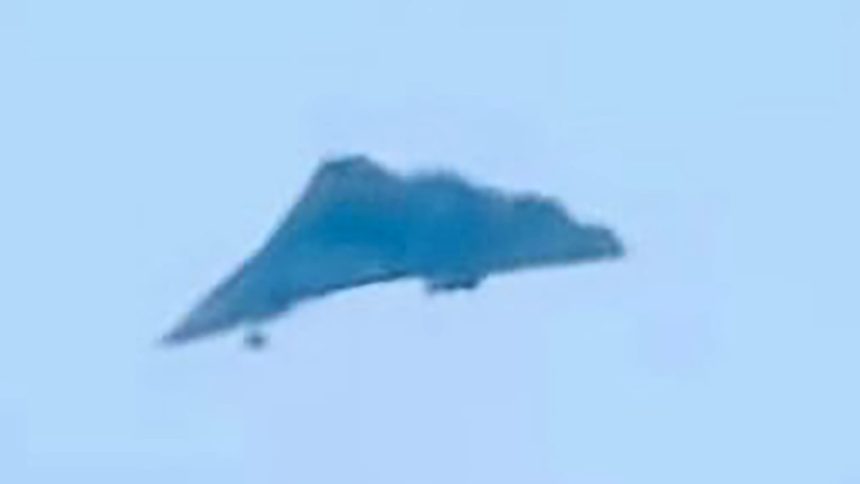Photographs of a previously unseen Chinese stealthy platform have surfaced online.
Some photos are taken from distance, but other frames are shot straight up from below with the aircraft flying above. And, provided they are genuine, they’re clear enough: China has flown yet another tailless aircraft. If you’ve been following our coverage of the J-36 concept and the J-XDS demonstrator, you’ll recognize the family resemblance. This is a third silhouette of a flying Chinese stealthy aircraft.
In our previous pieces we noted how China appeared to be iterating tailless deltas with different inlet placements and wing loadings, searching for the sweet spot between low observability, supersonic efficiency and controllability without vertical tails. This new aircraft extends that pattern: multiple flying prototypes, each probing a different corner of the design tradespace, rather than one paper design inching toward production.
🇨🇳 China Unknown Manned/Unmanned Tailless Aircraft
We Have a Arm Race inside of Our Country pic.twitter.com/3cUGJi2nlU
— David Wang (@Nickatgreat1220) August 4, 2025
The images confirm a two-segment trailing edge, with a straight center section that sharply angles outward before extending to the wingtips. This planform matches the geometry seen in the J-36 design studies we reported on in the recent past and is likely intended to improve lift-to-drag performance in the transonic flight regime.
It appears China has flown a 3rd type of 6th gen tailless fighter design.
It isn’t clear if this is manned or unmanned.
Man or unmanned, it is clearly a supersonic, ultra-stealthy air combat aircraft.
The US must be in panic mode, or they may have accepted the reality of… pic.twitter.com/uqAASaGDcW
— Zhao DaShuai 东北进修🇨🇳 (@zhao_dashuai) August 4, 2025
The two inlets suggest a dual engine aircraft. The slender probe on the nose is classic first-flight kit. Above it, there might be a cockpit with a canopy although this is not clear. Anyway, at the moment the most likely one seems to be the optionally-piloted or unmanned theory.
Flat nozzle? Saw-tooth shrouds? IR suppression? So far, the photos don’t show the exhaust section clearly enough. At the moment we don’t have a clue about the actual size of the aircraft either: until we gather additional details through imagery we are unable to judge size and say whether it is this closer to a manned fighter or a large UCAV.
Allegedly another image of that mysterious CCA UCAV … however it could also be again just a stupid joke!
So let us be skeptical & cautious instead of immediately assuming that it is a 3rd new “next-generation” fighter, a bomber or even a secret stealth swing-wing naval-fighter pic.twitter.com/Qat7X0y2oz
— @Rupprecht_A (@RupprechtDeino) August 4, 2025
Strategic implications
The United States has its own tailless NGAD demonstrator airborne, confirmed by the U.S. President and the service leadership, if not yet photographed, but the Chinese program is now on at least its third flying test article/demonstrator in less than one year.
Modern VLO (very-low-observable) fighters want to minimize planform alignment breaks and high-RCS corners. Ditching vertical tails removes two of the biggest radar reflectors on an airplane. The trade is stability and control authority, especially at high angles of attack and during crosswind operations. Solving that takes powerful flight-control laws, nose-to-tail sensors, thrust-vectoring, or all three.
If China is now routinely flying tailless, supersonic demonstrators, it suggests a level of confidence in those control solutions and in signature management around the engine inlets and exhaust.
A new image was revealed showing the supposed to be CCA (loyal wingman) designs for the upcoming military parade. pic.twitter.com/drqx7dR83U
— @Rupprecht_A (@RupprechtDeino) August 3, 2025
Does this put the United States “in panic mode”? That’s not how this works. The U.S. has been pursuing its own tailless Next Generation Air Dominance (NGAD) path and flying full-scale flight demonstrators in secrecy for years.
What these photos suggest is that Beijing is running a parallel, high-tempo program with multiple airframes in the air, compressing the learning loop. Whether the end product is a manned sixth-gen fighter, a family of unmanned loyal wingmen similar to the American CCA concept or both, the message is the same: China is running fast.









